初中英语动词分类大全
- 格式:docx
- 大小:32.77 KB
- 文档页数:23
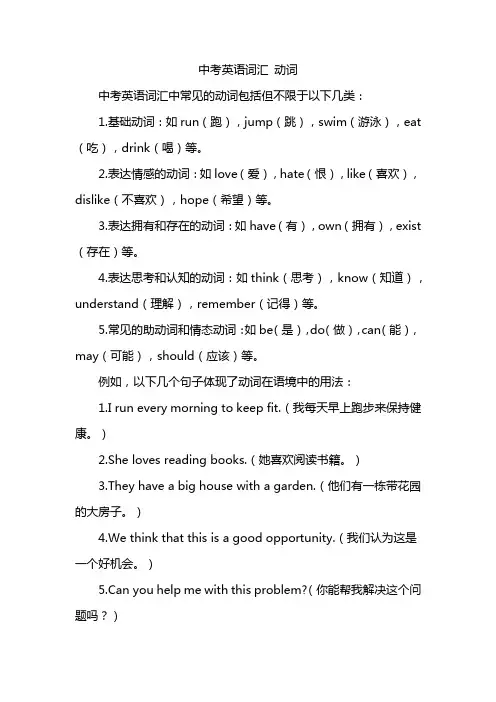
中考英语词汇动词
中考英语词汇中常见的动词包括但不限于以下几类:
1.基础动词:如run(跑),jump(跳),swim(游泳),eat (吃),drink(喝)等。
2.表达情感的动词:如love(爱),hate(恨),like(喜欢),dislike(不喜欢),hope(希望)等。
3.表达拥有和存在的动词:如have(有),own(拥有),exist (存在)等。
4.表达思考和认知的动词:如think(思考),know(知道),understand(理解),remember(记得)等。
5.常见的助动词和情态动词:如be(是),do(做),can(能),may(可能),should(应该)等。
例如,以下几个句子体现了动词在语境中的用法:
1.I run every morning to keep fit.(我每天早上跑步来保持健康。
)
2.She loves reading books.(她喜欢阅读书籍。
)
3.They have a big house with a garden.(他们有一栋带花园的大房子。
)
4.We think that this is a good opportunity.(我们认为这是一个好机会。
)
5.Can you help me with this problem?(你能帮我解决这个问题吗?)。
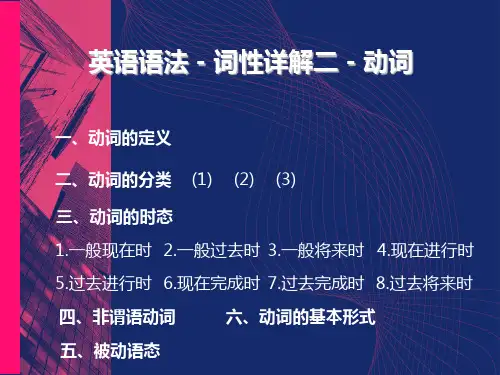
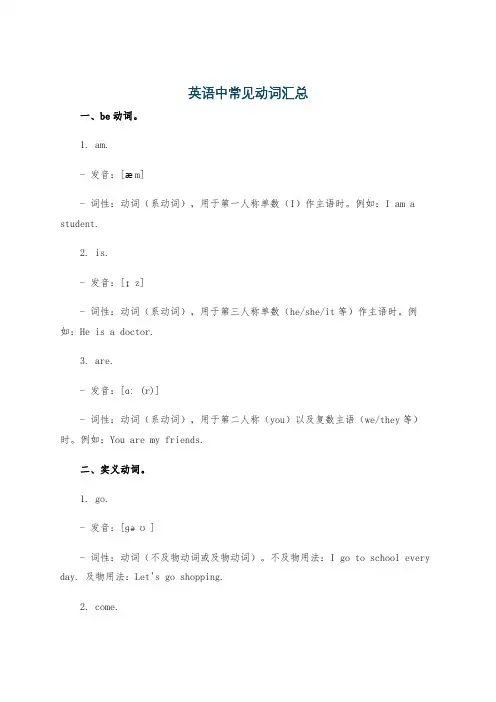
英语中常见动词汇总一、be动词。
1. am.- 发音:[æm]- 词性:动词(系动词),用于第一人称单数(I)作主语时。
例如:I am a student.2. is.- 发音:[ɪz]- 词性:动词(系动词),用于第三人称单数(he/she/it等)作主语时。
例如:He is a doctor.3. are.- 发音:[ɑː(r)]- 词性:动词(系动词),用于第二人称(you)以及复数主语(we/they等)时。
例如:You are my friends.二、实义动词。
1. go.- 发音:[ɡəʊ]- 词性:动词(不及物动词或及物动词)。
不及物用法:I go to school every day. 及物用法:Let's go shopping.2. come.- 词性:动词(不及物动词)。
例如:Come here, please.3. do.- 发音:[duː](原形),[dʊ](弱读形式)- 词性:动词(及物动词或助动词)。
作为及物动词:I do my homework. 作为助动词:Do you like English?4. make.- 发音:[meɪk]- 词性:动词(及物动词)。
例如:She makes a cake.5. take.- 发音:[teɪk]- 词性:动词(及物动词)。
例如:Take this book.6. give.- 发音:[ɡɪv]- 词性:动词(及物动词)。
例如:Give me a pen.7. get.- 发音:[ɡet]- 词性:动词(及物动词或不及物动词)。
不及物用法:I get up early. 及物用法:I get a present.8. put.- 词性:动词(及物动词)。
例如:Put your book on the desk.9. see.- 发音:[siː]- 词性:动词(及物动词)。
例如:I see a bird in the tree.10. look.- 发音:[lʊk]- 词性:动词(不及物动词或及物动词)。
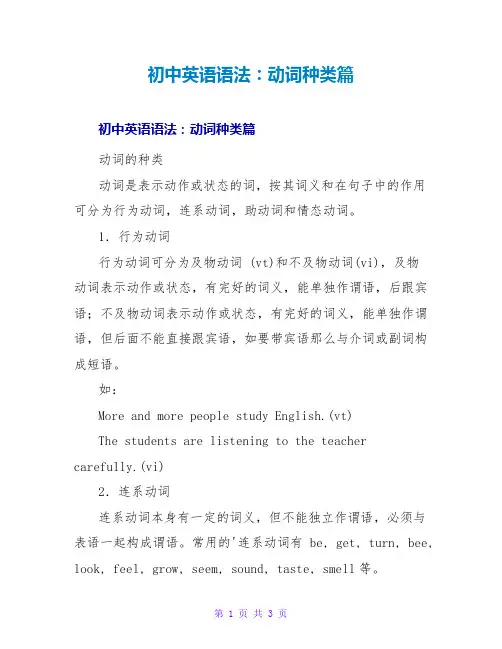
初中英语语法:动词种类篇初中英语语法:动词种类篇动词的种类动词是表示动作或状态的词,按其词义和在句子中的作用可分为行为动词,连系动词,助动词和情态动词。
1.行为动词行为动词可分为及物动词 (vt)和不及物动词(vi),及物动词表示动作或状态,有完好的词义,能单独作谓语,后跟宾语;不及物动词表示动作或状态,有完好的词义,能单独作谓语,但后面不能直接跟宾语,如要带宾语那么与介词或副词构成短语。
如:More and more people study English.(vt)The students are listening to the teacher carefully.(vi)2.连系动词连系动词本身有一定的词义,但不能独立作谓语,必须与表语一起构成谓语。
常用的'连系动词有 be, get, turn, bee, look, feel, grow, seem, sound, taste, smell等。
如:Our country is being stronger and stronger.It feels d.3.助动词助动词本身无词义,不能单独作谓语,只能和主要动词一起构成谓语动词,表示否认,疑问及动词的时态、语态、人称和数等语法特征,助动词有 be,do,have,shall,will等。
如:How do you usually e to school?The children are playing yo-yo now.4.情态动词情态动词本身有一定的意义,但不能独立作谓语,只能和主要动词原形一起构成谓语,表示说话人的语气和情态。
情态动词没有人称和数的变化。
情态动词有 can(could),may(might),must, need, ought to, dare等。
如:Can I help you?- Must we go now? -No, you needn't .a. can与be able to的用法有所区别。
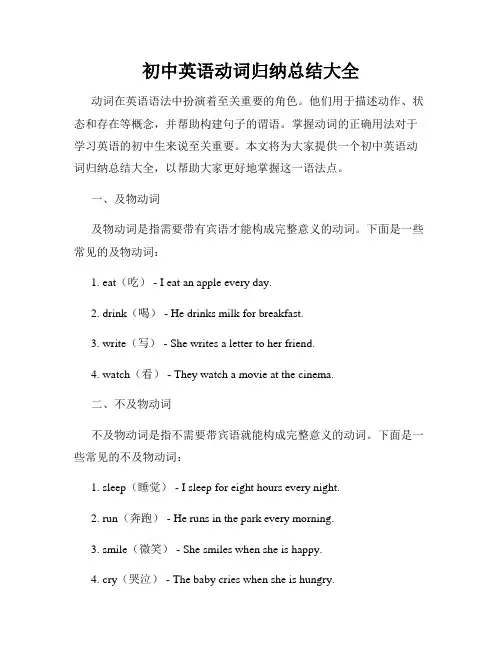
初中英语动词归纳总结大全动词在英语语法中扮演着至关重要的角色。
他们用于描述动作、状态和存在等概念,并帮助构建句子的谓语。
掌握动词的正确用法对于学习英语的初中生来说至关重要。
本文将为大家提供一个初中英语动词归纳总结大全,以帮助大家更好地掌握这一语法点。
一、及物动词及物动词是指需要带有宾语才能构成完整意义的动词。
下面是一些常见的及物动词:1. eat(吃) - I eat an apple every day.2. drink(喝) - He drinks milk for breakfast.3. write(写) - She writes a letter to her friend.4. watch(看) - They watch a movie at the cinema.二、不及物动词不及物动词是指不需要带宾语就能构成完整意义的动词。
下面是一些常见的不及物动词:1. sleep(睡觉) - I sleep for eight hours every night.2. run(奔跑) - He runs in the park every morning.3. smile(微笑) - She smiles when she is happy.4. cry(哭泣) - The baby cries when she is hungry.三、状态动词状态动词描述主语的状态或性质,不表示具体的动作。
常见的状态动词有:1. be(是,存在) - They are students.2. feel(感觉) - I feel tired today.3. seem(似乎) - It seems difficult to understand.4. appear(出现) - The sun appears in the sky every morning.四、助动词助动词用于构成各种时态和语态,辅助主要动词的运用。
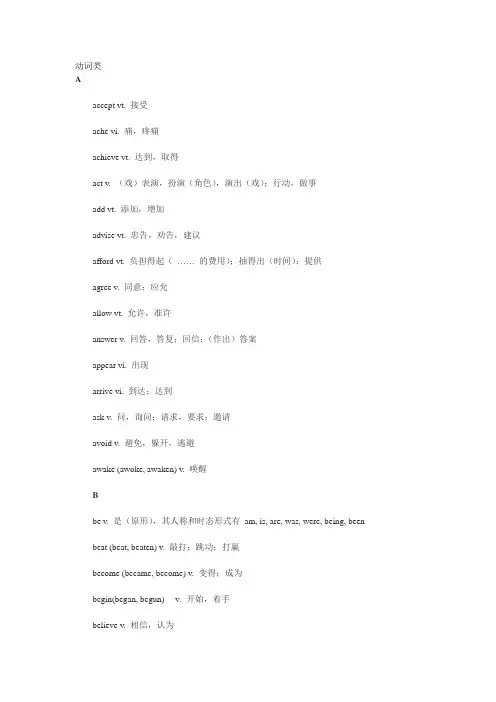
动词类Aaccept vt. 接受ache vi. 痛,疼痛achieve vt. 达到,取得act v. (戏)表演,扮演(角色),演出(戏);行动,做事add vt. 添加,增加advise vt. 忠告,劝告,建议afford vt. 负担得起(…… 的费用);抽得出(时间);提供agree v. 同意;应允allow vt. 允许,准许answer v. 回答,答复;回信;(作出)答案appear vi. 出现arrive vi. 到达;达到ask v. 问,询问;请求,要求;邀请avoid v. 避免,躲开,逃避awake (awoke, awaken) v. 唤醒Bbe v. 是(原形),其人称和时态形式有am, is, are, was, were, being, been beat (beat, beaten) v. 敲打;跳动;打赢become (became, become) v. 变得;成为begin(began, begun) v. 开始,着手believe v. 相信,认为board v. 上(船、火车、飞机)book v. 预定,定(房间、车票等)borrow v. (向别人)借用;借break (broke, broken) v. 打破(断,碎);损坏,撕开breathe vi. 呼吸bring (brought, brought) vt. 拿来,带来,取来brush v. 刷;擦build (built, built) v. 建筑;造burn (burned, burned 或burnt, burnt)v. 燃,烧,着火;使烧焦;使晒黑buy(bought, bought) vt. 买Ccall v. 称呼;呼唤;喊,叫can modal v. 可能;能够;可以cancel vt. 取消care v. 介意…… ,在乎;关心carry vt. 拿,搬,带,提,抬,背,抱,运等catch(caught, caught) v. 接住;捉住;赶上;染上(疾病)cause vt. 促使,引起,使发生celebrate v. 庆祝change v. 改变,变化;更换;兑换cheat v. 骗取,哄骗;作弊cheer vi. 欢呼;喝彩check vt. 校对,核对;检查;批改choose (chose, chosen) vt. 选择circle vt. 圆圈;将…… 圈起来clap vi. 拍手;鼓掌clean vt. 弄干净,擦干净climb v. 爬,攀登close vt. 关,关闭coat vt. 给…… 穿外套;涂上collect vt. 收集,搜集come (came, come) vi. 来,来到colour ( 美color) vt. 给…… 着色,涂色communicate v. 交际;传达(感情,信息等)compare vt. 比较,对照complete vt. 完成,结束connect vt. 连接,把…… 联系起来consider vt. 考虑continue vi. 继续control vt. 控制cook v. 烹调,做饭copy v. 抄写;复印;(计算机用语)拷(备份)correct v. 改正;纠正cost (cost, cost) v. 值(多少钱);花费cough vi. 咳嗽could modal v.(can 的过去式)可以…;(表示许可或请求)可以……count vt. 数,点数cover v. 覆盖,遮盖;掩盖create vt. 创造;造成cross vt. 越过;穿过cry v. 喊叫;哭cut (cut, cut) v. 切,剪,削,割Ddance vi. 跳舞dare v.& aux.(后接不带to 的不定式;主要用于疑问,否定或条件句)敢,敢于decide v. 决定;下决心depend vi. 依靠,依赖,指望;取决于describe vt. 描写,叙述develop v. (使)发展;(使)发达;(使)发育;开发vt. 冲洗(照片)die v. 死dig (dug, dug) v. 挖(洞、沟等);掘direct vt.指挥;指导;监督;管理;指挥;导演(电影)discover vt. 发现discuss vt. 讨论,议论dismiss vt. 让…… 离开;遣散;解散;解雇disturb vt. 扰乱;打扰do (did, done) don't=do notv. & aux.做,干(用以构成疑问句及否定句)divide vt. 分,划分doubt v. 怀疑,疑惑draw (drew, drawn) v. 绘画;绘制;拉,拖;提取(金钱)dream (dreamt, dreamt 或dreamed, dreamed)vt. 梦,梦想dress v. 穿衣;穿着drive(drove, driven) v. 驾驶,开(车);驱赶drink(drank, drunk) v. 喝,饮dry v. 使…… 干;弄干;擦干Eeat (ate, eaten) v. 吃encourage vt. 鼓励e-mail v. 发电子邮件end v. 结束,终止enjoy vt. 欣赏;享受…… 之乐趣;喜欢enter vt. 进入examine vt. 检查;诊察excite vt. 使兴奋,使激动exercise vi. 锻炼excuse vt. 原谅;宽恕expect vt. 预料;盼望;认为explain vt. 解释,说明express vt. 表达;表示Fface vt. 面向;面对fail v. 失败;不及格;衰退fall (fell, fallen) vi. 落(下),降落;倒feed (fed, fed) vt. 喂(养);饲(养)feel (felt, felt) v.& link 感觉,觉得;摸,触fetch vt.(去)取(物)来,(去)带(人)来fight (fought, fought) v. 打仗(架)fill vt. 填空,装满film vt. 拍摄,把…… 拍成电影find (found, found) vt. 找到,发现,感到finish v. 结束;做完fire vi. 开火,开(枪,炮等),射击fish vi. 钓鱼;捕鱼fit v.(使)适合,安装fix vt. 修理;安装;确定,决定fly (flew, flown) vi. (鸟、飞机)飞;(人乘飞机)飞行;(旗子等)飘动vt. 空运(乘客,货物等);放(风)follow vt. 跟随;仿效;跟得上force vt. 强迫,迫使forget (forgot, forgotten) v. 忘记;忘掉freeze (froze, frozen) vi. 结冰Gget (got , got) vt. 成为;得到;具有;到达give (gave, given) vt. 给;递给;付出;给予go (went, gone) vi. 去;走;驶;通到;到达grow (grew, grown) v. 生长;发育;种植;变成guess vi. 猜Hhand v. 递;给;交付;交上;交进hang (hanged, hanged) v. 处(人)绞刑;上吊hang (hung, hung) v. 悬挂,吊着;把…… 吊起happen vi.(偶然)发生has v. 动词have 的第三人称单数现在式hate vt. 恨,讨厌have (had, had) vt. 有;吃;喝;进行;经受head v. 率领;加标题;用头顶;出发;( 船等) 驶向hear (heard, heard) v. 听见;听说, 得知heat vt. 把…… 加热help vt. 帮助,帮忙hide (hid, hidden) v. 把…… 藏起来,隐藏hit (hit, hit) vt. 打,撞,击中hold (held, held) vt. 拿;抱;握住;举行;进行hope v. 希望howl vi. 嚎叫,嚎哭hurry vi. 赶快;急忙hurt (hurt, hurt) vt. 伤害,受伤;伤人感情Iimagine vt. 想像,设想improve vt. 改进,更新include vt. 包含,包括increase v. 增加,繁殖influence v. 影响interview vt.采访,会见,面试introduce vt. 介绍invent vt. 发明,创造invite vt. 邀请,招待iron vt. 熨烫Jjoin v. 参加,加入;连接;会合jump v. 跳跃;惊起;猛扑Kkeep (kept, kept) v. 保持;保存;继续不断kick v. 踢kill v. 杀死,弄死kiss vt. 吻,亲吻knock v. 敲;打;击know(knew, known) v. 知道,了解;认识;懂得Llack vt. 缺乏,缺少land v. 登岸(陆);降落last v. 持续laugh v. 笑,大笑;嘲笑lay (laid, laid) vt. 放,搁lead (led, led) v. 领导,带领learn (learnt, learnt ;learned, learned) vt. 学,学习,学会leave (left, left) v. 离开;把…… 留下,剩下lend (lent, lent) vt. 借(出),把…… 借给let (let, let) vt. 让lie1 vi. 谎言; 说谎lie2 (lay, lain) v. 躺;卧;平放;位于lift v. 举起,抬起;(云、烟等)消散light vt. 点(火),点燃like vt. 喜欢,喜爱line v. 画线于,(使)成行link v. 连接;联系listen vi. 听, 仔细听live vi. 生活;居住;活着lock vt. 锁,锁上look v. 看,观看lose (lost, lost) vt. 失去,丢失love vt. 爱;热爱;很喜欢Mmail v.(美)邮寄make(made, made) vt. 制造,做;使得manage v. 管理;设法对付mark vt. 标明,作记号于marry v.(使)成婚,结婚master vt. 精通,掌握match vt. 使相配,使成对matter vi. 要紧,有重大关系may modal v. 可以;也许,可能mean(meant, meant)vt. 意思是,意指meet (met, met) vt. 遇见,见到会;集会mend v. 修理,修补mention vt. 提到,说起;提名表扬might v. modal. (may 的过去式,助动词) 可能,也许,或许milk vt. 挤奶mind v. 介意,关心miss vt. 失去,错过,缺mistake (mistook, mistaken) vt. 弄错move v. 移动,搬动,搬家murder vt. 谋杀must modal v. 必须,应当;必定是Nname vt. 命名,名叫nod vi. 点头note vt. 记下,记录;注意,留意notice vt. 注意,注意到Ooffer vt. 提供;建议open vt. 开,打开order vt. 定购,定货;点菜own v. 拥有,所有Ppaint vt. 油漆,粉刷,绘画park vt. 停放(汽车)part v. 分离;分开;分割pass vt. 传,递;经过;通过pay (paid, paid) v. 付钱,给…… 报酬phone = telephone v. 打电话pick v. 拾起,采集;挑选picnic v. 野餐place v. 放置,安置,安排plan v. 计划,打算plant vt. 种植,播种play v. 玩;打(球);游戏;播放please v. 请;使人高兴,使人满意point v. 指,指向post v. 投寄;邮寄practise( 美practise) v. 练习,实践praise vt. 赞扬,表扬prepare vt. 准备, 预备;调制,配制prevent vt. 防止,预防print vt. 印刷produce vt. 生产;制造progress vi. 进展;进行promise vi. 答应,允诺pronounce vt. 发音protect vt. 保护prove vt. 证明provide vt. 提供,供应,供给pull v. 拉,拖punish v. 惩罚,处罚push v. 推put (put, put) vt. 放,摆Qquestion vt. 询问Rrain vi. 下雨raise vt. 使升高;饲养reach v. 到达,伸手(脚等)够到read (read, read) v. 读;朗读realise ( 美realize) vt. 认识到,实现reason vi. 评理;劝说receive v. 收到,得到recite v. 背诵refuse vi. 拒绝,不愿regard v. 看待,尊敬regret vt. 可惜,遗憾;痛惜;哀悼relax v. (使)放松,轻松remain vt. 余下,留下vi. 保持,仍是remember v. 记得,想起repair vt. 修理;修补repeat vt. 重说,重做report v. 报道,报告require vt. 需求;要求rest vi. 休息,歇息retell vt. 重讲,重复,复述return v. 归还,回,归review vt. 重新调查;回顾;复习ride (rode, ridden) v. 骑(马、自行车);乘车ring (rang, rung) v.(钟、铃等)响;打电话rise (rose, risen) vi. 上升,上涨rock vt. 摇,摇晃rule vt. 统治;支配row v. 划船run (ran, run) vi. 跑,奔跑;(颜色)褪色rush vi. 冲,奔跑Ssail v. 航行,开航satisfy vt. 满足,使满意save vt. 救,挽救,节省say (said, said) vt. 说,讲score v. 得分,分数search v. 搜寻,搜查see (saw, seen) vt. 看见,看到;领会;拜会seem v. 似乎,好像sell (sold, sold) v. 卖send (sent, sent) v. 打发,派遣;送,邮寄separate v. 使分开,使分离serve vt. 招待(顾客等),服务set vt. 设置(布景,背景)shake (shook, shaken) v.(使)动摇,震动shall (should) v. modal.(表示将来)将要,会;…… 好吗shape v. 使成型,制造,塑造share vt. 分享,共同使用shine (shone, shone) v. 发光;照耀;杰出;擦亮ship vi. 用船装运shop vi. 买东西should v. mod. 应当,应该,会v. aux. 会,应该(shall 的过去时态)shout v. 喊,高声呼喊show (showed, shown) v. 给…… 看,出示,显示shut (shut, shut) v. 关上,封闭;禁闭;sing (sang, sung) v. 唱,唱歌sit (sat, sat) vi. 坐skate vi. 溜冰,滑冰sleep (slept, slept) vi. 睡觉smell (smelt, smelt) v.嗅,闻到;发气味smile v. 微笑smoke v. 冒烟;吸烟snake v. 蛇般爬行;蜿蜒行进snow vi. 下雪sort vt. 把…… 分类,拣选sound vi. 听起来;发出声音speak (spoke, spoken) v. 说,讲;谈话;发言speed v.(使)加速spell(spelt, spelt)vt. 拼写spend (spent, spent) v. 度过;花费(钱、时间等)spread (spread, spread)v.延伸;展开stand (stood, stood) v. 站;立;起立;坐落;经受;持久start v. 开始,着手;出发stay vi. 停留,逗留,呆steal (stole, stolen) vt. 偷, 窃取step vi. 走;跨步stick (stuck, stuck) vi. 粘住,钉住;坚持stop v. 停,停止,阻止store vt. 储藏,存储study v. 学习;研究succeed vi. 成功suggest vt. 建议,提议supply vt. 供给,供应suppose vt. 猜想,假定,料想surprise vt. 使惊奇,使诧异sweep(swept, swept) v. 扫除,扫swim (swam, swum) vi. 游泳,游swing vt. 挥舞,摆动Ttake (took, taken) vt. 拿;拿走;做;服用;乘坐;花费talk v. 谈话,讲话,演讲;交谈taste vt. 品尝, 尝味teach(taught, taught) v. 教书,教telephone v. 打电话tell (told, told) vt. 告诉;讲述;吩咐test vt. 测试, 考查,试验thank vt. 感谢,致谢,道谢think(thought, thought) v. 想;认为;考虑time vt. 测定…… 的时间,记录…… 的时间throw(threw, thrown) v. 投,掷,扔tie vt.(用绳,线)系,拴,扎tidy vt. 弄整洁,弄干净total v. 合计为touch vt. 触摸,接触trade vt. 用…… 进行交换train v. 培训, 训练translate vt. 翻译travel vi. 旅行treat vt. 对待,看待trouble vt. 使苦恼,使忧虑,使麻烦truck v. 装车;用货车运trust vt. 相信,信任,信赖try v. 试,试图,努力turn v. 旋转,翻转,转变,转Uunderstand (understood, understood) v. 懂得;明白;理解up v. 举起;拿起;提高use vt.利用,使用,应用Vvisit vt. 参观,访问,拜访Wwait vi. 等,等候wake(woke, woken) v. 醒,醒来,叫醒walk v. 步行;散步want vt. 想,想要;需要,必要warn vt. 警告,预先通知wash v. 洗(涤);冲洗;流过;弄湿waste vt. 浪费watch vt. 观看,注视;当心,注意water v. 浇水wear(wore, worn) v. 穿,戴weigh vt. 称……的重量,重(若干)welcome v. 欢迎will(would modal v. 将,会(表示将来);愿意,要wish vt. 希望,想要,祝愿wonder v. 对……疑惑,感到惊奇,想知道work vi. 工作;(机器、器官等)运转,活动worry v. 烦恼,担忧,发怒;困扰wound v. 击伤write(wrote, written) v. 写,书写;写作,著述。
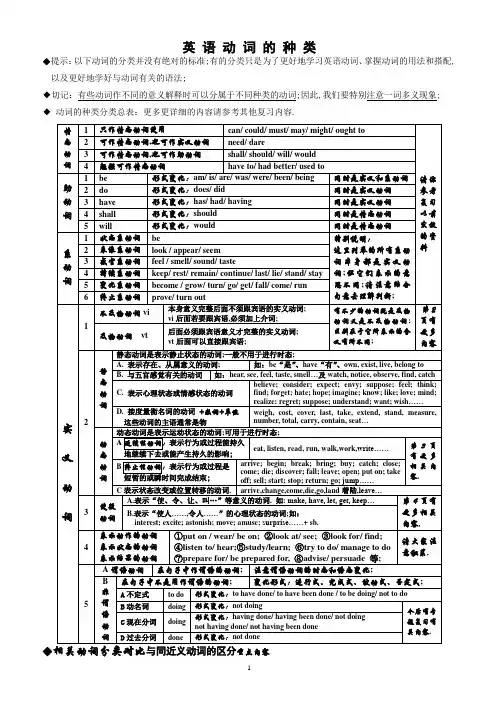
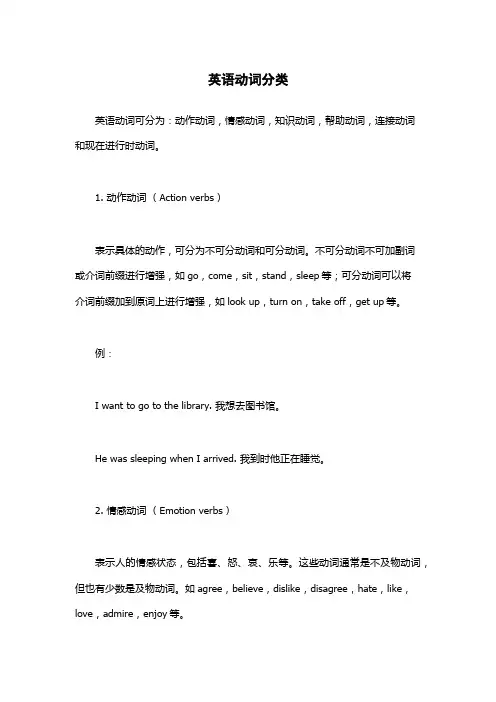
英语动词分类英语动词可分为:动作动词,情感动词,知识动词,帮助动词,连接动词和现在进行时动词。
1. 动作动词(Action verbs)表示具体的动作,可分为不可分动词和可分动词。
不可分动词不可加副词或介词前缀进行增强,如go,come,sit,stand,sleep等;可分动词可以将介词前缀加到原词上进行增强,如look up,turn on,take off,get up等。
例:I want to go to the library. 我想去图书馆。
He was sleeping when I arrived. 我到时他正在睡觉。
2. 情感动词(Emotion verbs)表示人的情感状态,包括喜、怒、哀、乐等。
这些动词通常是不及物动词,但也有少数是及物动词。
如agree,believe,dislike,disagree,hate,like,love,admire,enjoy等。
例:I admire your courage. 我敬佩你的勇气。
She dislikes going to parties. 她不喜欢参加派对。
3. 知识动词(Cognitive verbs)表示人的思维活动,如看、听、想、知道等,说明人们获取知识、心情、思想等方面活动。
如:know、think、learn、understand、comprehend等。
例:I know the answer to that question. 我知道这个问题的答案。
He learned a lot from his mistakes. 他从自己的错误中学到了很多东西。
4. 帮助动词 (Auxiliary verbs)表示有可能的、可能的、过去的、过去的方式等情况,是语法上重要的词汇。
有be、do、have三种。
例:Have you finished your work yet? 你完成工作了吗?She is writing an essay. 她正在写一篇文章。
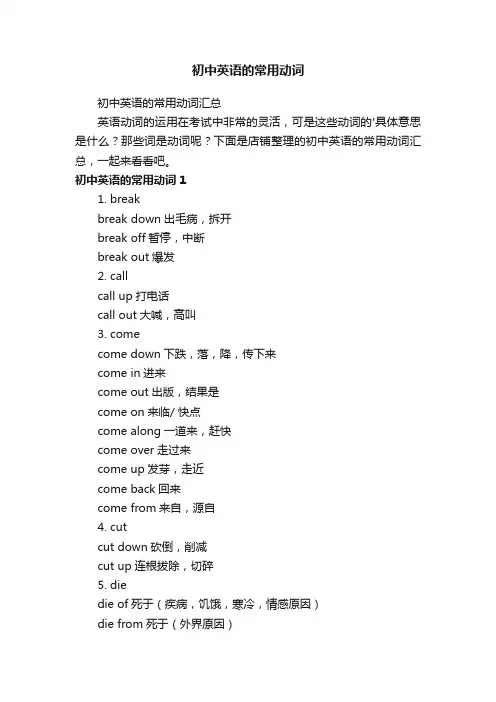
初中英语的常用动词初中英语的常用动词汇总英语动词的运用在考试中非常的灵活,可是这些动词的'具体意思是什么?那些词是动词呢?下面是店铺整理的初中英语的常用动词汇总,一起来看看吧。
初中英语的常用动词11. breakbreak down出毛病,拆开break off暂停,中断break out爆发2. callcall up打电话call out大喊,高叫3. comecome down下跌,落,降,传下来come in进来come out出版,结果是come on来临/ 快点come along一道来,赶快come over走过来come up发芽,走近come back回来come from来自,源自4. cutcut down砍倒,削减cut up连根拔除,切碎5. diedie of死于(疾病,饥饿,寒冷,情感原因)die from死于(外界原因)die out绝种6. fallfall behind落后fall down掉下,跌倒fall into 落入;陷入fall off 从……掉下fall out与……争吵7. gogo along沿着……。
走go through通过,经受go over复习,检查go up(价格)上涨,建造起来go against违反go away离开go by时间过去go down降低,(日、月)西沉go on(with)继续进行go out外出,熄灭go off发出响声8. getget down下来,记下,使沮丧get on进展,进步,穿上,上车get off脱下,下车get away逃跑,逃脱,去休假get over克服,从疾病中恢复get along with进展,相处get up起床get into (trouble) 陷入困境中get back取回,收回get out 出去get to 到达……9. givegive away赠送,泄露,出卖give out发出,疲劳,分发,give in (to sb.) 屈服give up放弃,让(座位)10. handhand in交上,提交hand out分发11.holdhold on to继续,坚持hold up举起,使停顿hold on别挂电话,等,坚持12. keepkeep up with跟上keep out 不使……进入keep from克制,阻止keep away from避开,不接近,keep on继续,坚持下来keep down 使……处于低水平13.knockknock at/on敲knock into撞到某人身上14. looklook up查找,向上看look through翻阅,浏览look after/ at / for 照顾/看/寻找look out(for)当心look about / around/round四下查看look forward to盼望make up编造,打扮,组成make into / of / from 制成16.passpass by经过pass down(on)to传给17. paypay back还钱,报复pay for付钱,因得到报应18. pickpick up拾起,接人,站起,收听,pick out挑选,辨认,看出19. putput up张贴,举起,put out伸出,扑灭put off推迟put into放进,翻译put away放好,存钱put down记下,平息put on穿戴,上映,put aside放到一边put back放回20. runrun after追逐,追捕run away逃跑run off跑掉,迅速离开run out of用完21. setset up建立set off 激起,引起take after 与相像take off脱掉,起飞take away拿走take up从事,占用(时间空间)take down记录,取下take back收回take pride in以为自豪,take the place of 代替23. thinkthink of想起,考虑,对看法think out(自然)想出办法think up想出(设计出、发明、编造)think about考虑think over仔细考虑24. turnturn off / on打开turn to翻到,转向,求助turn down调低,拒绝turn back返回,转回去turn round转过身来turn up向上翻,出现,音量调大25. carecare about 担心,关心;在乎,介意care for 关心,关怀,照顾26. cleanclean up 把打扫干净,把收拾整齐clean out 清除;把打扫干净27.learnlearn about 获悉,得知,认识到learn from 从/向……学习28. fightfight for..争取获得fight against 争取克服、战胜fight with与……搏斗/战斗29. dreamdream of梦想,想橡dream about 梦到……30. workwork for 为……工作work out 产生结果;发展;成功31. argueargue with 与……争论argue about..争论……32. complaincomplain to 向……抱怨complain about抱怨……33. hearhear of 听说,得知hear about听到……的事,听到……的话hear from接到……的信35. talktalk about 讨论……talk with/to..和……讨论36. livelive in 住在……live on 以……为主食37. standstand out 突显,引人注目stand up 起立,站起来38.其它常用词组wake up 醒,唤醒,弄醒stay up 不睡觉;熬夜depend on依靠;取决于worry about为……担忧laugh at嘲笑……begin with以……开始mix up混合、搀和major in 主修grow up成长open up 打开,张开;开发end up到达或来到某处;达到某状态throw away 丢弃……ask for要求……wait for等待……agree with同意……find out(经研究或询问)获知某事send out 发出,放出,射出search for 搜索,搜查chop down 砍到have.. on 穿着……step out of 跨步走出drop out of 从……掉出happen to 发生在……belong to属于arrive in /at到达……try on试穿……vote on对……进行投票strech out伸展……hang out闲逛leave for离开前往初中英语的常用动词21)come back 回来2)come down 下来3)come in 进入,进来4)come on 快,走吧,跟我来5)come out出来6)come out of 从……出来7)come up 上来8)come from 来自……9)do one's lessons/homework 做功课/回家作业10)do more speaking/reading 多做口头练习/朗读11)do one's best 尽力12)do some shopping (cooking reading, cleaning)买东西(做饭菜,读点书,大扫除)13)do a good deed (good deeds)做一件好事(做好事)14)do morning exercises 做早操15)do eye exercises 做眼保健操16)do well in 在……某方面干得好初中英语的常用动词31. take away 拿走2. take off 脱下,起飞,休假3. day off / have off 休假4. take photos 拍照5. take some medicine 服药6. turn on 开,旋开电灯,收音机等7. turn off 关上电灯,收音机等8. turn down 把音量调低9. turn up10. turn in 交出,上交11. turn…into… 变成12. turn…over 把……翻过来13. at once 立刻 at last 最后14. at first 起先,首先15. at the age of… 在……岁时16. at the end of… 在……之末17. by the end of… 到……底为止18. at the beginning of… 在……之初初中英语的常用动词41. have a rest 休息一会儿2. have a talk 谈话3. have a walk =take a walk 散步4. make friends with与……交朋友5. make a living 谋生6. make a mistake mistakes犯错误7. make a sentence be made from/of 由……制成8. be made in 在……地方制造9. look after =take care of照管,照看,10. look for 寻找11. look like 看上去像12. look out 当心,小心13. look around 朝四周看14. look at 看着……15. put on 穿上衣服,戴上帽子16. put up 张帖17. set up 竖起,建起【初中英语的常用动词汇总】。
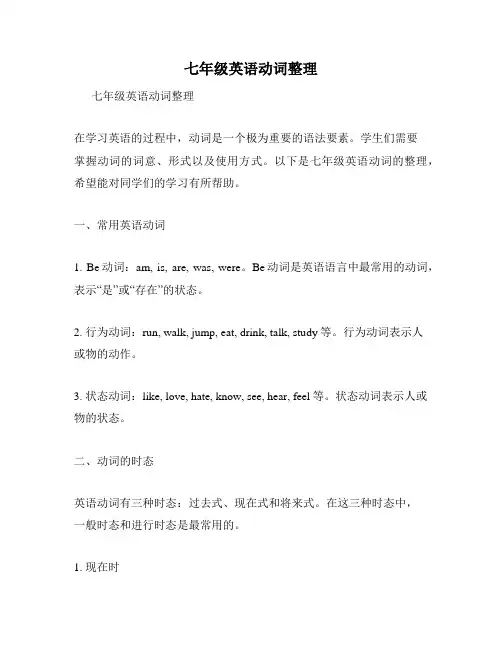
七年级英语动词整理七年级英语动词整理在学习英语的过程中,动词是一个极为重要的语法要素。
学生们需要掌握动词的词意、形式以及使用方式。
以下是七年级英语动词的整理,希望能对同学们的学习有所帮助。
一、常用英语动词1. Be动词:am, is, are, was, were。
Be动词是英语语言中最常用的动词,表示“是”或“存在”的状态。
2. 行为动词:run, walk, jump, eat, drink, talk, study等。
行为动词表示人或物的动作。
3. 状态动词:like, love, hate, know, see, hear, feel等。
状态动词表示人或物的状态。
二、动词的时态英语动词有三种时态:过去式、现在式和将来式。
在这三种时态中,一般时态和进行时态是最常用的。
1. 现在时(1)一般现在时:表示经常性的或普通的动作,如:I like to watch TV.(我喜欢看电视。
)(2)进行时:表示正在进行的动作,如:She is reading a book.(她正在读一本书。
)2. 过去时(1)一般过去时:表示过去完成的动作,如:I watched a movie last night.(我昨晚看了一部电影。
)(2)进行时:表示过去正在进行的动作,如:He was playing basketball when I saw him.(当我看到他的时候,他正在打篮球。
)3. 将来时(1)一般将来时:表示将来会发生的事情,如:I will go to the beach next weekend.(下个周末我会去海滩。
)(2)进行时:表示将来会正在进行的事情,如:They will be studying at this time tomorrow.(明天这个时候他们会正在学习。
)三、动词的形式英语动词有原形、过去式、过去分词和现在分词四种形式,同学们需要牢记各个动词的不同形式。
1. 过去式和过去分词:动词加-ed。
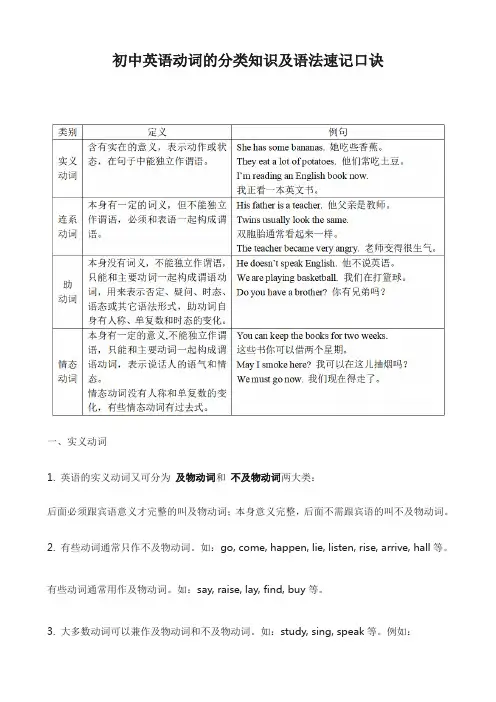
初中英语动词的分类知识及语法速记口诀一、实义动词1. 英语的实义动词又可分为及物动词和不及物动词两大类:后面必须跟宾语意义才完整的叫及物动词;本身意义完整,后面不需跟宾语的叫不及物动词。
2. 有些动词通常只作不及物动词。
如:go, come, happen, lie, listen, rise, arrive, hall等。
有些动词通常用作及物动词。
如:say, raise, lay, find, buy等。
3. 大多数动词可以兼作及物动词和不及物动词。
如:study, sing, speak等。
例如:Who is going to speak at the meeting?谁打算在会上发言?(speak作不及物动词)Few people outside China speak Chinese.在中国以外很少人讲汉语。
(speak作及物动词)4. 有些动词作及物动词与作不及物动词时的意义有所不同。
如:know, wash等。
例如:It’s your turn to wash dishes.轮到你洗碗了。
I had to wash and dress in a hurry.我得赶紧洗漱穿衣。
5. 有些动词常和介词、副词或其它词类一起构成固定词组,形成短语动词。
如:listen, reply, wait, look等。
二、连系动词连系动词用来连接主语和表语,连系动词后面常为形容词。
1. 表示“是”的动词be。
这个词在不同的主语后面和不同的时态中有不同的形式,is,am,are,was,were,have / has been等要特别予以注意。
例如:He is a teacher.他是个教师。
We are Chinese.我们是中国人。
2. 表示“感觉”的词,如look(看起来),feel(觉得,摸起来),smell(闻起来),sound(听起来),taste(尝起来)等。
例如:She looked tired.她看一去很疲劳。
动词有哪些大全动词是语言中的重要组成部分,它能够描述行为、状态和变化。
在英语中,动词有很多种类,每种类型都有其独特的用法和特点。
下面我们来详细了解一下动词有哪些大全。
一、行为动词。
行为动词是用来描述人或物体的动作或行为的动词,它可以表示具体的动作或行为,如run(跑)、jump(跳)、eat(吃)等。
行为动词是英语中最常见的动词类型,它们通常用来构成句子的谓语部分,描述主语的动作或行为。
二、状态动词。
状态动词是用来描述人或物体的状态或性质的动词,它可以表示持续性的状态或者是某种特定的状态,如be(是)、have(有)、know(知道)等。
状态动词通常用来构成句子的谓语部分,描述主语的状态或性质。
三、情态动词。
情态动词是用来表示说话人的情感、态度或推测的动词,它可以表示可能性、必要性、意愿等,如can(能够)、may(可能)、must(必须)等。
情态动词通常和其他动词一起构成谓语,用来表示说话人对某种情况的看法或态度。
四、助动词。
助动词是用来构成英语时态、语态和语气等的动词,它通常和其他动词一起构成谓语,用来表示句子的时态、语态或语气,如be(是)、do(做)、have(有)等。
助动词在句子中起到辅助的作用,帮助其他动词构成谓语。
五、及物动词。
及物动词是需要接受动作的宾语才能构成完整意义的动词,它通常后面需要接宾语,如read(阅读)、write(写作)、eat(吃)等。
及物动词在句子中需要有宾语的存在,才能表达完整的意思。
六、不及物动词。
不及物动词是不需要接受动作的宾语就能构成完整意义的动词,它通常后面不需要接宾语,如sleep(睡觉)、walk(走路)、run(跑)等。
不及物动词在句子中可以独立存在,表达完整的意思。
七、及物不及物动词。
及物不及物动词是既可以作及物动词使用,也可以作不及物动词使用的动词,它可以根据句子的需要来选择是否接受宾语,如open(打开)、close(关闭)、break(打破)等。
第一讲动词的分类动词是表示动作或状态的词。
句子中的谓语成分是由动词充当的,谓语通常是句中不可缺少的成分,因此动词是英语词类中最重要的一种。
动词可以通过本身的变化来表示动作发生的时间以及说话人的语气、态度等。
1.动词的种类动词按其词义和在句中的作用可以分为:行为动词(或称实义动词)、连系动词、助动词和情态动词。
1)行为动词又可分为及物动词(vt.)和不及物动词(vi.)两种。
及物动词作谓语,后面必须跟宾语意思才完整。
不及物动词作谓语,后面不能跟宾语,只有加上介词后才可接宾语。
2)英语中有些动词常常是既作及物动词又作不及物动词;既作连系动词工作及物动词。
例如:He speaks English very well. (vt.)He spoke at the meeting. (vi.)另外,动词按其在句中能否作谓语,又可分为谓语动词(finite verb)和非谓语动词(non-finite verb)两大类。
说明:谓语动词又称限定动词,非谓语动词又称非限定动词。
非谓语动词初中阶段主要学习动词不定式的用法。
2.动词的基本形式英语动词有五种基本形式,即动词原形、过去式、过去分词、现在分词和第三人称单数形式。
如:work—worked—worked—working—works。
它们的构成及说明:1)词尾-ed在清辅音后读[t];在浊辅音和元音后读[d];在[t]和[d]后读[id]。
2)词尾-es或-s在[s ]、[z]、[t ]、[d ]后面读[iz];在清辅音后读[s];在浊辅音及元音后读[z];在[t],[d]后读[ts]、[dz]。
3)不规则动词的过去式与过去分词则要根据不规则动词表逐渐记住。
第二讲动词的时态1.一般现在时1)构成动词一般现在时,除主语为单数第三人称以外,谓语动词一律用原形,若主语为第三人称单数,则谓语动词的词尾应发生变化(加-s或-es)。
另外be和have 有特殊的人称变化形式。
人教版初中英语动词分类表一、行为动词(Action Verbs)行为动词是用来描述人或事物所做的动作的词语。
1. 动作类行为动词(Action Verbs of Movement):动作类行为动词(Action Verbs of Movement):- run(跑)- walk(走)- jump(跳)- swim(游泳)- dance(跳舞)- speak(说话)- listen(听)- read(读)- write(写)二、状态动词(State Verbs)状态动词用来描述人或事物的状态,不表示动作。
1. 感官类状态动词(State Verbs of Senses):感官类状态动词(State Verbs of Senses):- see(看见)- hear(听见)- smell(闻到)- taste(品尝)- feel(感觉)2. 心理类状态动词(State Verbs of Mental Processes):心理类状态动词(State Verbs of Mental Processes):- think(思考)- believe(相信)- know(知道)- prefer(更喜欢)- remember(记得)三、延续性动词(Continuative Verbs)延续性动词用来表示一个动作或状态的持续性。
1. 持续动作类延续性动词(Continuative Verbs of Continuous Action):持续动作类延续性动词(Continuative Verbs of Continuous Action):- study(研究)- work(工作)- sing(唱歌)- play(玩)- sleep(睡觉)2. 持续状态类延续性动词(Continuative Verbs of Continuous State):持续状态类延续性动词(Continuative Verbs of Continuous State):- exist(存在)- belong(属于)- lie(躺)- sit(坐)- stand(站)四、完成性动词(Perfective Verbs)完成性动词用来表示一个动作或状态的完成。
初中英语语法知识点整理总结-动词动词是句子的中心词,用来表示人或物的动作、状态、变化等。
掌握动词的正确使用对于研究英语语法至关重要。
以下是初中英语动词知识点的整理总结:1. 动词的分类- 及物动词:表示动作的动词,需要带宾语才能构成完整的意义。
例如:read(读),eat(吃)。
- 不及物动词:表示动作的动词,不需要带宾语。
例如:run (跑),sleep(睡觉)。
- 连系动词:表示状态的动词,连接主语和表语,没有实际意义。
例如:be(是),seem(似乎)。
2. 动词的时态- 现在时:表示目前正在进行的动作或状态。
例如:I read a book.(我正在读一本书。
)- 过去时:表示过去发生的动作或状态。
例如:She ate an apple yesterday.(她昨天吃了一个苹果。
)- 将来时:表示将来要发生的动作或状态。
例如:They will go to the zoo tomorrow.(他们明天会去动物园。
)3. 动词的语态- 主动语态:表示主语是动作的执行者。
例如:Jim cleans the room.(吉姆打扫房间。
)- 被动语态:表示主语是动作的承受者。
例如:The room is cleaned by Jim.(房间被吉姆打扫了。
)4. 动词的情态- can:表示能力或许可。
例如:She can swim.(她会游泳。
)- must:表示必须。
例如:You must finish your homework.(你必须完成你的作业。
)- should:表示建议或义务。
例如:You should help others.(你应该帮助别人。
)以上是初中英语动词的一些基本知识点,希望对你的研究有所帮助。
初中英语动词分类大全(附练习)一、什么是动词动词是用来表示主语做什么(即行为动词),或表示主语是什么或怎么样(即状态动词)的词,例如:The boy runs fast.(这个男孩跑得快。
)runs表示主语的行为He is a boy.(他是个男孩。
)is与后面的表语a boy表示主语的状态二、动词的分类动词可以按照含义及它们在句中的作用分成四类,即行为动词(也称实义动词)、连系动词、助动词和情态动词。
(一)行为动词行为动词(实义动词)是表示行为、动作或状态的词。
它的词义完整,可以单独作谓语。
例如:I live in Beijing with my mother.(我和我妈妈住在北京。
)live,住It has a round face.(它有一张圆脸。
)has,有(二)连系动词连系动词是表示主语“是什么”或“怎么样”的词,它虽有词义,但不完整,所以不能单独作谓语,必须跟表语一起构成合成谓语,例如:We are in Grade Two this year.(今年我们在两年级。
)are,是are 这个词的词义“是”在句子中常常不译出。
连系动词可具体分为三类:1、表示“是”的动词be。
这个词在不同的主语后面和不同的时态中有不同的形式,is,am,are,was,were,have/has been等要特别予以注意。
例如:He is a teacher.(他是个教师。
)He was a soldier two years ago.(两年前他是个士兵。
)We are Chinese.(我们是中国人。
)2、表示“感觉”的词,如look(看起来),feel(觉得,摸起来),smell(闻起来),sound(听起来),taste(尝起来)等,例如:She looked tired.(她看一去很疲劳。
)I feel ill.(我觉得不舒服。
)Cotton feels soft.(棉花摸起来很软。
)The story sounds interesting.(这个故事听起来很有趣。
英语动词分类及用法表一、实义动词(Notional Verbs)实义动词是表示动作或状态的动词,能独立作谓语。
(一)及物动词(Transitive Verbs)及物动词后面必须跟宾语,意思才完整。
例如:“I love you”(我爱你。
)中的“love”就是及物动词,“you”是宾语。
常见的及物动词有:“eat”(吃)、“read”(读)、“write”(写)、“buy”(买)、“sell”(卖)等。
及物动词的用法:1、主语+及物动词+宾语He plays football(他踢足球。
)She reads a book(她读书。
)2、主语+及物动词+宾语+宾语补足语They made the room clean(他们把房间打扫干净了。
)We call him Tom(我们叫他汤姆。
)(二)不及物动词(Intransitive Verbs)不及物动词本身意义完整,后面不需要跟宾语。
例如:“The bird flies”(鸟飞。
)中的“flies”就是不及物动词。
常见的不及物动词有:“sleep”(睡觉)、“run”(跑)、“swim”(游泳)、“laugh”(笑)、“cry”(哭)等。
不及物动词的用法:1、主语+不及物动词The sun rises(太阳升起。
)It rains(下雨了。
)二、系动词(Linking Verbs)系动词用于连接主语和表语,表示主语的身份、性质、状态等。
常见的系动词有:1、状态系动词:be(am/is/are/was/were)I am a student(我是一名学生。
)They were happy(他们曾经很开心。
)2、持续系动词:keep, remain, stayHe always keeps silent(他总是保持沉默。
)The weather remains cold(天气仍然很冷。
)3、表象系动词:seem, appearShe seems tired(她看起来很累。
初中英语动词分类大全(附练习)一、什么是动词动词是用来表示主语做什么(即行为动词),或表示主语是什么或怎么样(即状态动词)的词,例如:The boy runs fast.(这个男孩跑得快。
)runs表示主语的行为He is a boy.(他是个男孩。
)is与后面的表语a boy表示主语的状态二、动词的分类动词可以按照含义及它们在句中的作用分成四类,即行为动词(也称实义动词)、连系动词、助动词和情态动词。
(一)行为动词行为动词(实义动词)是表示行为、动作或状态的词。
它的词义完整,可以单独作谓语。
例如:I live in Beijing with my mother.(我和我妈妈住在北京。
)live,住It has a round face.(它有一张圆脸。
)has,有(二)连系动词连系动词是表示主语“是什么”或“怎么样”的词,它虽有词义,但不完整,所以不能单独作谓语,必须跟表语一起构成合成谓语,例如:We are in Grade Two this year.(今年我们在两年级。
)are,是are 这个词的词义“是”在句子中常常不译出。
连系动词可具体分为三类:1、表示“是”的动词be。
这个词在不同的主语后面和不同的时态中有不同的形式,is,am,are,was,were,have/has been等要特别予以注意。
例如:He is a teacher.(他是个教师。
)He was a soldier two years ago.(两年前他是个士兵。
)We are Chinese.(我们是中国人。
)2、表示“感觉”的词,如look(看起来),feel(觉得,摸起来),smell(闻起来),sound(听起来),taste(尝起来)等,例如:She looked tired.(她看一去很疲劳。
)I feel ill.(我觉得不舒服。
)Cotton feels soft.(棉花摸起来很软。
)The story sounds interesting.(这个故事听起来很有趣。
)The flowers smell sweet.(这些花闻起来很香。
)The mixture tasted horrible.(这药水太难喝了。
)3、表示“变”、“变成”的意思的词,如become, get, grow,turn, 都解释为“变”、“变得”,例如:She became a college student.(她成了一名大学生。
)He feels sick. His face turns white.(他感到不舒服,他的脸色变苍白了。
)The weather gets warmer and the days get longer when spring comes.(春天来了,天气变得暖和些了,白天也变得较长些了。
)He grew old.(他老了。
)[难点解释]注意区别以下一些动词的用法,它们既可以作为行为动词,又可以作为连系动词。
1、look看;看起来He is looking at the picture.(他正在看这图片。
)行为动词It looks beautiful.(它看上去很美丽。
)连系动词2、fell摸;感觉1)I felt someone touch my arm.(我感到有人碰我的手臂。
)行为动词Are you felling better today than before?(你今天比以前感到好些了吗?)连系动词3、smell嗅;闻起来My little brother likes to smell the apple before he eats it.(我的小弟弟喜欢在吃苹果前闻一闻。
)行为动词Great! The flowers smell nice.(这些花闻起来多香啊!)连系动词4、sound弄响,发音;听起来The letter “h” in hour is not sounded.(在hour这个词中字母h是不发音的。
)行为动词The gun sounded much closer.(枪声听起来更近了。
)连系动词5、taste辨味;尝起来Please taste the soup.(请尝一口汤。
)行为动词The soup tastes terrible.(这汤尝起来味道太差了。
)连系动词6、get得到,获得;变There are some bananas on the table. Each of you can get one.(桌上有些香蕉,你们每个人可以拿一个。
)行为动词7、grow生长,种植;变Do you grow rice in your country?(你们的国家种水稻吗?)行为动词It’s too late. It’s growing dark.(太迟了,天渐渐变暗了。
)连系动词8、turn转动,翻动,使变得;变The earth turns around the sun.(地球绕着太阳转。
)行为动词When spring comes, the trees turn green and the flowers come out.(春天来了,树叶变经绿了,花儿开了。
)连系动词上述句子中的动词如grow、get、turn等,既可以作连系动词,又可以作行为动词。
如何来辨别它们呢?有一个最简便的方法,即用连系动词be替换句子中的这些动词,句子仍然成立就是连系动词;反之,不能替换的,就是行为动词。
例如:The trees turn/are green when spring comes.(春天来临,树叶变绿。
)The earth rurns around the sun.(地球绕着太阳转。
)这第二句句子中的turn是行为动词,意为“转动”。
无法以is替换。
(三)助动词这类词本身无词义,不能单独作谓语,只能与主要动词一起构成谓语,表示不同的时态、语态、表示句子的否定和疑问,例如:He does not speak English well.(他英语讲得不好。
)句中的does是助动词,既表示一般现在时,又与not一起构成否定形式。
A dog is running after a cat.(一条狗正在追逐一只猫。
)句中的is 是助动词,和run的现在分词一起构成现在进行时。
Did he have any milk and bread for his breakfast ?(他早餐喝牛奶、吃面包吗?)句中的did是助动词,既表示一般过去时,又和动词have一起构成疑问。
(四)情态动词这类词本身虽有意义,但不完整。
它们表示说话人的能力、说话人的语气或情态,如“可能”、“应当”等。
这类动词有can, may, must, need, dare, could, might等。
它们不能单独作谓语,必须与行为动词(原形)一起作谓语,表示完整的意思,例如:I can dance.(我会跳舞。
)can, 能, 会He can’t walk because he is a baby.(因为他是个婴儿,不会走路。
)can’t, 不必May I come in?(我可以进来吗?)may, 可以第二节及物动词与不及物动词行为动词(即实义动词)按其是否需要宾语,可以分为及物动词和不及物动词。
一、及物动词后面必须跟宾语,意思才完整,例如:Give me some ink, please.(请给我一些墨水。
)If you have any questions, you can raise your hands.(如果你们有问题,你们可以举手,。
)二、不及物动词后面不能跟宾语,意思已完整。
不及物动词有时可以加上副词或介词,构成短语动词,相当于一个及物动词。
例如:He works hard.(他工作努力。
)Jack jruns faster than Mike.(杰克跑步比迈克要快些。
)Please look at the blackboard and listen to me.(请看黑板,听我说。
)He got and “A” this time because he went over his lessons carefully.(这次他得了个“A”,因为他仔细地复习了功课。
)[难点解释]1、许多动词可用作及物动词,也可用作不及物动词,他阅读中必须仔细体会和区别,例如:Who is going to speak at the meeting?(谁打算在会上发言?)speak, 不及物动词Few people outside China speak Chinese.(在中国外很少人讲汉语。
)speak,及物动词2、要特别注意有些动词英汉之间的差异。
某些词在英语中是不及物的,而在汉语中却是及物的。
有时则相反。
例如:He is waiting for you.(他在等你。
)英语wait为不及物动词,汉语“等”为及物动词。
Serve the people.(为人民服务。
)英语serve为及物动词,汉语“服务”为不及物动词。
Exercise 1指出下列各句中划线部分是什么动词,并说明词义,例如:All of us study hard.(vi. 学习)1、He began to work at seven this morning.()2、I have left the key at home.()3、We must take the old woman to the hospital at once.()4、Billy felt very sad when he heard the bad news.()5、Think it over, and you will have a good idea.()6、Don’t think of yourself;think of others.()7、We are college students now, but we were at thefactory two years ago.()8、Mr. Black got angry when he saw Jenny come to schoollate again.()9、Please wash your hands before each meal.()10、Li Ming often works for the wall-newspaper afterschool.()Exercise 2区别下列多组句子中的动作,指出下列划线动词是连系动词还是行为动词,并写出词义:1、She looks well.()She tried to look at the blackboard but wawnothing.()2、The students felt unhappy.()I felt someone touch my back.()3、It was snowing hard when he got to the city.()It’s too late. It’s getting darker anddarker.()4、The teacher asked the student to turn it over.()The leaves of the trees turn green when spingcomes.()5、The young trees grow fast.()It began to grow dark.()6、The bell sounded at 12 o’clock for lunch.()The music sounds nice.()第三节持续动词与瞬间动词英语的行为动词有持续性动词和瞬间性动词之分,使用中应注意两者的区别。